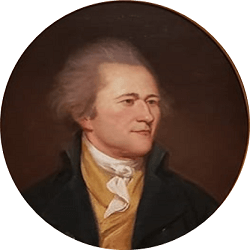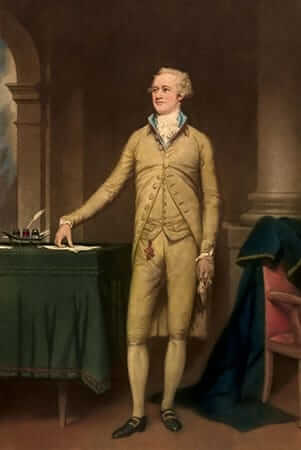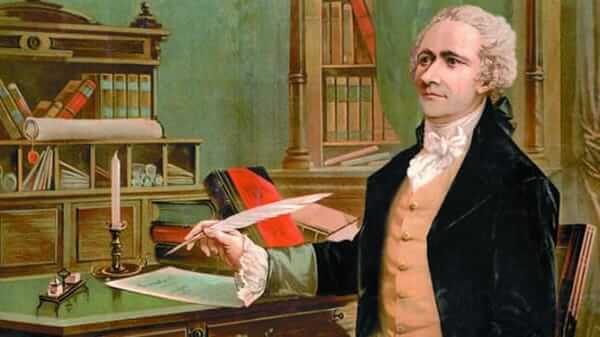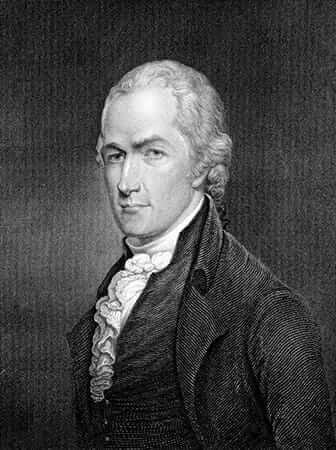Alexander Hamilton
Born on January 11, 1755, or 1757, Alexander Hamilton was a founding father, statesman, and American revolutionary. He was a powerful interpreter and ambassador for the United States. The Federalist Party, the country's banking structure, the US National Guard, and the NY Post were all founded by him, together with the US Constitution. Hamilton was a key contributor to the economic policy of President George Washington's administration as the initial secretary of the treasury. He played a crucial role in building the nation's inaugural two de facto central banks, a structure of tariffs, the restart of cordial commercial relations with Britain, and the federal government's payment of the provinces' American Revolutionary War debts. His strategy called for an effective administrative branch, a strong national military, and a robust commercial sector. Charlestown, Nevis, is the location of Hamilton's wedlock birth. He was adopted as an orphan and was brought up by a prosperous merchant. When he was in his teens, customers from the locality sent him to New York to finish his schooling. While still a student, he penned essays and delivered lectures under a pseudonym in favour of the Continental Congress. He enlisted in the militia at a young age as the American Revolutionary War began. As an artillery officer in the fledgling Continental Army, he participated in New York and New Jersey wars. In 1777, he became a senior counsellor on General George Washington's staff. He quickly departed to assume command in the field just in time for a vital combat that ended the siege of Yorktown. Though occasionally impulsive, Hamilton is widely recognized as an intelligent and academically talented administrator, statesman, and banker. His theories are credited with creating the framework for American politics and economics. Early lifeAlexander Hamilton, the Meyer of Cambuskeith, Ayrshire, Scotland, was the father of James Hamilton, a nomadic trader. His mother was Rachel Fawcett Lavine, who was married to John Michael Lavine, a merchant who had landed on the island of St. Croix in the Danish West Indies and was the son of a French Huguenot surgeon. Although Lavine did not divorce Rachel until 1758, James Hamilton and Rachel most probably moved in together in 1752. James Hamilton left his family in 1765, and Rachel opened a little business after becoming homeless. When Alexander was 11, he started working as an assistant in the accounting office of two New York merchants that had recently relocated to St. Croix. Alexander gained promotion from bookkeeper to supervisor in 1772 after becoming a ward of his mother's relatives after Rachel died in 1768. This was made possible by his talent, persistence, and likeable manner. Friends sent him to a prep school in Elizabethtown, New Jersey, and he eventually entered King's College (later Columbia) in New York in the fall of 1773. He became a dedicated and successful student due to his intense ambition, but the growing Revolution against Great Britain forced him to stop studying. In public disobedience of the tea tax, Boston colonists damaged several tea cargoes during the Boston Tea Party, which he openly defended. He published three influential pamphlets in 1774-1775 that criticized British policy in Quebec and backed the decisions made by the Continental Congress regarding the importation, consumption, and exportation of British goods. The first conclusive proof of Hamilton's youth came from those anonymous writings, one of which was credited to John Jay and John Adams, two of the most skilled American propagandists. EducationBecause their parents were not officially married, Alexander and James Hamilton Jr. were not allowed to join the Church of England or attend church school. While their mother was still alive, they attended a private school run by a Jewish directress where they received "specific tutoring" and classes. Alexander used the 34-book home library as a supplement to his schooling. 
Hamilton travelled by ship to Boston in October 1772 and then to New York City. He moved in with Irish-born Hercules Mulligan, whose brother was a trader familiar to Hamilton's supporters and helped Hamilton sell the cargo to raise money for his studies and support. Later in 1772, Hamilton began filling in the gaps in his education at the Francis Barber-run Elizabethtown Academy in Elizabethtown, New Jersey, to prepare for college. He became influenced by William Livingston, a prominent scholar and revolutionary in the area with whom he shared a residence for a while. Hamilton enrolled at King's College, now Columbia University, on the time of fall of 1773 in New York City. He once boarded with Mulligan until May 1774, when he formally graduated. On July 6, 1774, at the Liberty Pole at King's College, in what is considered to be Hamilton's first appearance, Robert Troup, a lifetime friend and roommate from college, praised Hamilton's precision in concisely outlining the patriots' argument against the British. An unknown literary organization founded by Hamilton, Troup, and four other undergraduates is regarded as the founder of the Philolexian Society. In response to a series of pamphlets written by Church of England cleric Samuel Seabury in support of the Loyalist cause, Hamilton anonymously wrote his first political works, A Full Affirmation of the Actions of Congress and The Farmer Refuted. Intending to prevent a possible union of the colonies, Seabury essentially aimed to instil dread among the colonies. Hamilton published two more articles criticizing the Quebec Act and is suspected of writing the fifteen anonymous "The Monitor" articles for Holt's Journal in New York. Although he disapproved of mob retaliation against Loyalists, Hamilton supported the Revolutionary cause during this pre-war period. On May 10, 1775, Hamilton gained national attention by speaking to the crowd for long enough for Myles Cooper, the Loyalist head of his college, to escape from an enraged mob. As a result of the college closing down during the British occupation of the city, Hamilton was obliged to stop his studies before receiving his degree. Hamilton cleared the bar exam in July 1782 after completing his military service and some months of independent research. In October 1782, he received his license to represent clients in court proceedings before the State of New York's Supreme Court. In recognition of his efforts in getting Columbia College back on its feet financially and reopening it, Hamilton received a Master of Arts from the institution in 1788. In 1791, Hamilton was chosen to join the American Philosophical Society. Personal lifeHamilton met Elizabeth Schuyler, a daughter of General Philip Schuyler and Catherine Van Rensselaer, when stationed in Morristown, New Jersey, over the winter of 1779-1780. On December 14, 1780, they exchanged vows at the Schuyler Mansion in Albany, New York. Alexander Hamilton and Elizabeth had eight children, though there has been some confusion because there were two boys named Philip: Philip (1782-1801, died in a duel, just as his father would three years later), Angelica (1784-1857), Alexander Jr. (1786-1875), James Alexander (1788-1878), John Church (1792-1882), William Stephen (1797-1850), Eliza (1799-1859), and Philip, also called Little Phil (1802-1884), named in honour of his older brother. 
Three years before Hamilton's marriage to Elizabeth, the sisters of Elizabeth were very close to Hamilton. He was even said to have had an affair with Angelica, his wife's older sister, who had left the house with John Barker Church, an Englishman who had made a fortune in North America during the Revolution and afterwards relocated to Europe with his family between 1783 and 1797. Even though the tone of their connection during Angelica's fourteen-year stay in Europe was flirtatious, contemporary historians like Chernow and Fielding concur that despite rumours at the time, there is no proof that Hamilton and Angelica ever had a romantic or other close relationship that went beyond that of in-laws. Margarita, Elizabeth's younger sister, went by the nickname Peggy. She was the receiver of Hamilton's first letters praising Elizabeth at the time of their romance in early 1780. American RevolutionHamilton was appointed a major in the provincial artillery in March 1776, thanks to supporters in the New York legislature. He organized his own company and led his men with extraordinary bravery at the Battle of Trenton, preventing Lord Cornwallis' British force from crossing the Raritan River and attacking George Washington's main army. Washington extended an invitation to him in February 1777 to join the staff as a lieutenant colonel and aide-de-camp. He became close to the general during his four years on Washington's team and was given access to his correspondence. Hamilton engaged Elizabeth, the child of Gen. Philip Schuyler, the patriarch of one of New York's most illustrious families, to establish connections with riches and power. Since he spoke French fluently, he connected Washington and the French admirals and generals while on crucial military operations. Meanwhile, he pushed Washington for an effective command in the front after growing weary of the regular tasks at headquarters and craving for glory. Early in 1781, after Washington refused, Hamilton took advantage of a minor disagreement to sever ties with the general and depart his staff. He had fortunately not lost the general's goodwill, as Washington granted him leadership of a battalion in July. Hamilton oversaw an invasion of a British fortification during Cornwallis' army's October siege of Yorktown. Creation of political partiesNational political parties emerged due to the conflict over Hamilton's program and foreign policy issues. Hamilton, like Washington, had disliked gatherings and associated them with violence and uncertainty. He had planned to create a government of wise people who would rule independently of the party. Nevertheless, he rose to become the head of the Federalist Party, a group of politicians whose main goal was to back his policies. To get his proposal through Congress, Hamilton established himself as the leader of that party. He did this because he needed organized political backing and effective executive-branch leadership. The Republican Party, founded by House of Representatives member James Madison and Secretary of State Thomas Jefferson, was the political force that opposed the Hamiltonians. Hamilton intruded on Jefferson's vision of international affairs to bring out his plan. The Federalists sought friendly relations with England, while the Republicans favoured deepening the country's historical ties to France. 
He attempted to obstruct Jefferson's initiatives that may benefit France or harm England and persuade Washington to adhere to his own beliefs on foreign policy because he despised the French Revolution and the democratic ideals it gave rise to. Regarding foreign policy, Hamilton even went so far as to caution British officials about Jefferson's allegiance to France and advised them to work directly with the president and himself rather than the secretary of state. Jefferson and Hamilton fought over this and other aspects of Hamilton's plan, and they both tried to remove others from the council. In February 1793, when France and England went to war, Hamilton wanted to exploit the conflict as a reason to abandon the 1778 French alliance and move the United States nearer to England. Washington effectively followed Hamilton's suggestion and declared neutrality in April, commonly known as pro-British. Still, Jefferson maintained that the treaty remained binding. Hamilton opposed going to war with Great Britain due to British confiscation of American ships' trade with the French West Indies and other issues during the same period. Since his policy was based on work with Britain and the import charges that maintained his funding structure, he thought such a conflict would be national suicide. Hamilton convinced the president to transfer John Jay to London to conduct treaty negotiations, displacing the authority of the State Department. In particular, in a series of newspaper columns he published under the pen name Camillus, Hamilton drafted Jay's instructions, managed the negotiations, and supported the controversial treaty Jay brought back in 1795; the deal preserved the peace and maintained his system. The Burr quarrel of Alexander HamiltonHamilton helped found the Federalist newspaper, the New York Evening Post, in 1801 and erected a rural mansion on Manhattan Island called the Grange, whose policies resembled his own. Even though New England Federalists had rejected the purchase of Louisiana in 1803, he praised it through the Post. Some of them discussed secession and started negotiating with Burr for his support in 1804. Except for Hamilton, almost all Federalists supported Burr's bid for governor of New York State. Hamilton pushed for the election of Burr's Republican challenger, who prevailed by a slim margin, but it is unlikely that Hamilton's influence significantly impacted the result. In any case, Burr and Hamilton had been opponents for a long time, and Hamilton had often blocked Burr's plans. After the election, in June 1804, Burr requested Hamilton make decent on remarks he was believed to have delivered at a dinner in April, in which he supposedly expressed his "despicable opinion" of Burr. Despite disliking duelling, Hamilton accepted Burr's challenge because he was a man of honour. The two enemies met early on July 11 on the Weehawken Heights in Weehawken, New Jersey, where Hamilton's oldest son, Philip, had been killed in a duel three years previously. Burr's shot connected, causing Hamilton to fall. Friends helped Hamilton's wife and seven children pay off their enormous debts, which he left them. Popular CultureHamilton received comparatively less prominence in American popular culture during the 20th century than other Founding Fathers. Famous historical fiction works, many of which centred on different American political personalities of the era, have featured Hamilton prominently. The Conqueror, Being the True and Romantic Story of Alexander Hamilton by novelist Gertrude Atherton, released in 1902, is one of the literary works. Burr, a 1973 historical fiction by Gore Vidal, featured Hamilton as a pivotal figure.
Next TopicAgatha Christie
|
 For Videos Join Our Youtube Channel: Join Now
For Videos Join Our Youtube Channel: Join Now
Feedback
- Send your Feedback to [email protected]
Help Others, Please Share









